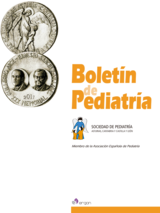Estudio de prevalencia y perfil clínico de la enfermedad reumática infantil en nuestro medio
S. Alperi García , M. Álvarez de Linera Alperi , M. Boto Pérez , J. Rodríguez Suárez , V. Martínez Suárez
Bol. Pediatr. 2017; 57 (242): 287 - 297
Los reumatismos constituyen un grupo de enfermedades crónicas degenerativas frecuentes en la infancia que afectan a la calidad de vida y pueden ocasionar secuelas, además de generar un gasto importante para las familias, un coste elevado para el sistema sanitario y repercutir en la escolaridad e integración del niño. Los cursos evolutivos, pronósticos y tratamientos de las diferentes condiciones de naturaleza reumatológica son variables. Con el fin de conocer la frecuencia en nuestro medio de las diferentes entidades de debut en la infancia hemos realizado un estudio descriptivo mediante revisión de las historias clínicas de los casos ingresados en el Área de Gestión Clínica de Pediatría (AGC) del Hospital Universitario Central de Asturias (HUCA) entre los años 2002 y 2017. Recogimos las variables individuales de edad, motivos de consulta, afectación articular y extraarticular, resultado de las pruebas diagnósticas, tratamientos recibidos y complicaciones. En total se incluyeron en el estudio 52 casos, siendo ampliamente predominante la artritis idiopática juvenil (AIJ), con la forma oligoarticular como la más diagnosticada (46,2% del total de la serie). Existió un predominio del género femenino (relación mujeres/hombres 1,5/1). La inflamación local fue el principal motivo de consulta (59,6%), seguida del dolor (50%), siendo la rodilla la articulación más frecuentemente afectada (63,4%). Entre las manifestaciones extraarticulares predominó la fiebre (15,4%); uveítis inicial presentaron el 7,7% de los casos, apareciendo posteriormente en el 26,9% (la mitad bilaterales). Respecto al tratamiento, todos recibieron antiinflamatorios no esteroideos, 51,9% metrotexato, 36,5% tratamiento con fármacos biológicos y 19 (36,5%) infiltraciones articulares.
Prevalence and clinical characterization of infantile rheumatic disease in a hospital reference setting
Rheumatisms constitute a group of chronic degenerative diseases which are common in childhood and affect the quality of life, causing significant consequences. Besides this, rheumatisms involve a substantial expenditure for the families, entail a high cost for the health system, and have a major impact on the child’s schooling process and integration. The evolutionary process, prognoses and treatments options for the different conditions of the rheumatic disease are varied. For the purpose of determining the frequency of the different entities of childhood debut in our environment, we have conducted a descriptive study by means of a review of the medical records of the cases admitted to the Clinical Management Unit of Pediatrics of the Hospital Universitario Central de Asturias (HUCA) from 2002 to 2017. We have collected the individual variables: age, reason for consultation, joint and extra-articular affectation, result of diagnostic tests, treatment received, and complications. A total of 52 cases have been included in the study, where juvenile idiopathic arthritis (JIA) has been observed as clearly predominant, being the oligoarticular variant the most diagnosed (46.2% of the total series). There has been a predominance of the female gender (female/male ratio 1.5/1). Local inflammation has been the main reason for consultation (59.6%), followed by pain (50%), with the knee joint most frequently affected (63.4%). Among the extra-articular manifestations, fever predominates (15.4%). Initial uveitis has been found in 7.7% of the cases, appearing later in 26.9% of them (half of these bilateral). Regarding treatments, all the patients have received non-steroidal anti-inflammatory drugs, 51.9% methotrexate, 36.5% treatment with biological drugs, and 19 (36.5%) joint infiltrations.
Artículo completo (PDF) (147 kb.)
- Traumatología/Ortopedia
